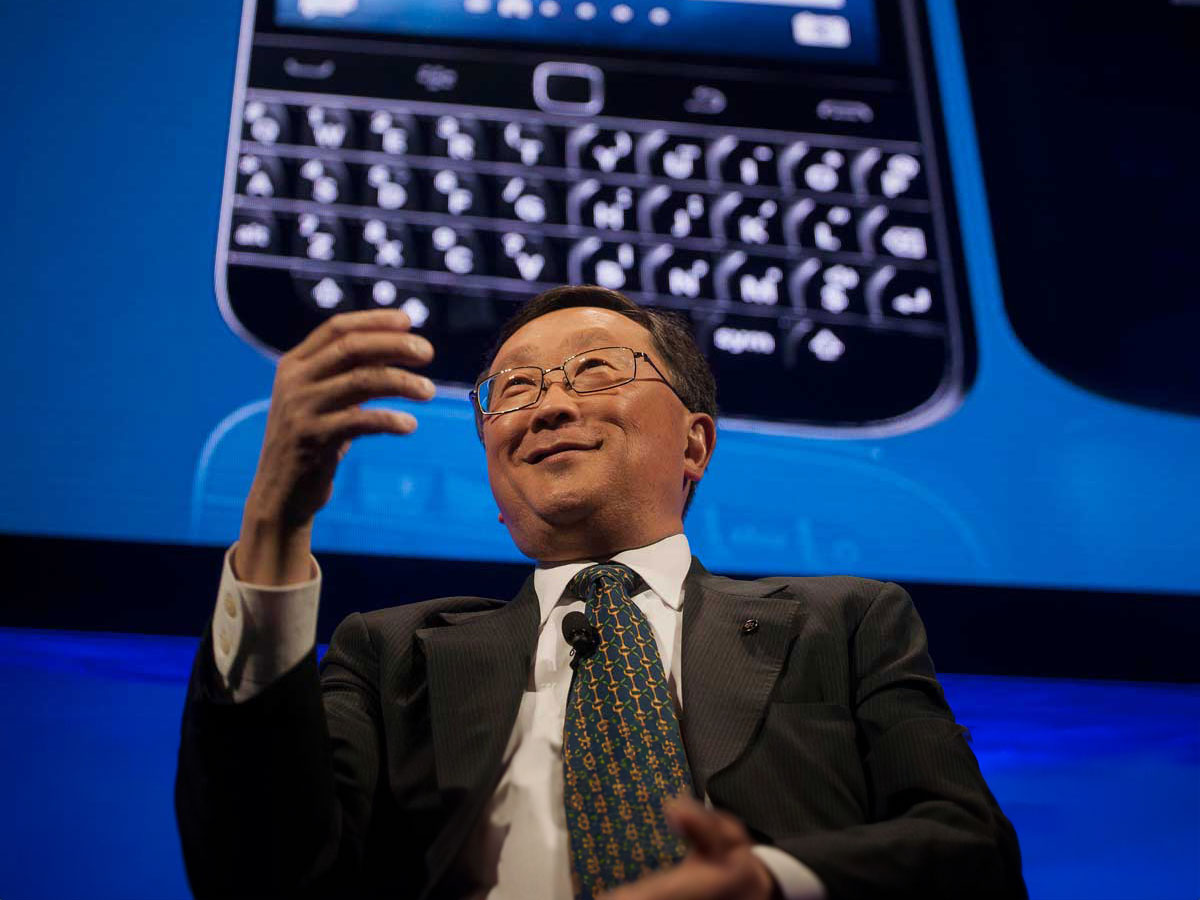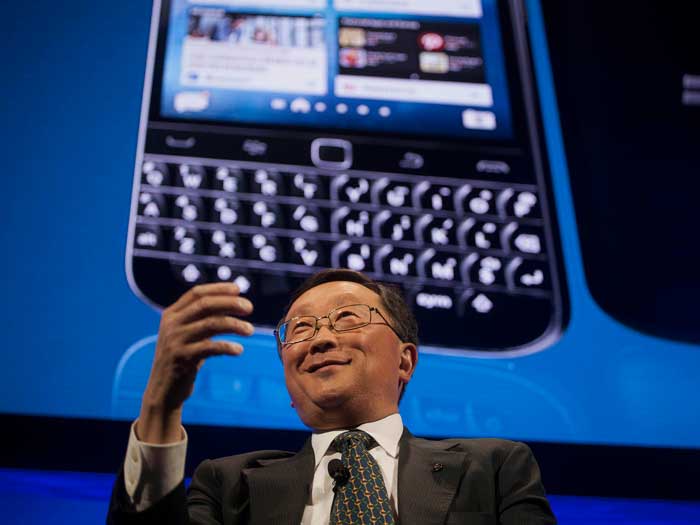
BlackBerry’s makeover brought the company back from the brink
 BlackBerry CEO John Chen is focused on wooing C-suite executives instead of gadget-loving consumers (Getty Images)
BlackBerry CEO John Chen is focused on wooing C-suite executives instead of gadget-loving consumers (Getty Images)
It was a sad start to the year for those few who still swear by their BlackBerry devices. On January 4, the company finally said so long to its handset software, leaving those who still used an older model BlackBerry-made device no longer able to reliably send texts, make phone calls or access data. While it’s possible to purchase devices (some prefer the physical keyboard) the BlackBerry as we all know it is officially dead.
BlackBerry, the company, though, is still very much alive. The Waterloo-based business, once the most valuable company on the Toronto Stock Exchange, has undergone a near total transformation, morphing into a company that sells enterprise security solutions and operating systems for increasingly connected cars. It’s taken several years for the company to transition from selling consumer technology to business-focused software, including cloud-based technologies, but most analysts say that the transformation is now complete.
Don’t, however, expect BlackBerry to become a household name again or reach its 2008 stock market highs, when the company, then called Research in Motion, was trading at $146 a share. (It’s now hovering at around $9 a share.) Fortunately, BlackBerry isn’t seeking public plaudits. John Chen, who was brought in as CEO in 2013 to take over from founder Mike Lazaridis and former CEO Jim Balsillie, FCPA, FCA, and take the company in a new direction, is now focused on wooing C-suite executives instead of gadget-loving consumers. “It’s a new business,” says Brian Partridge, research director with S&P Global Market Intelligence. “A different company with the same name.”
“We were all trying to build the device that would take off”
The company’s new era began when Chen, who previously—and famously—turned failing data software vendor Sybase into a multi-billion-dollar business, came on board. In 2013, BlackBerry shipped 19 million handset units around the world—well below the 49 million phones the company shipped just three years prior and nowhere near the 120 million smartphones that Apple sold in the U.S. alone that year.
At first, Chen hoped to salvage its device business (the company launched the BlackBerry Classic in 2014) while people inside the company were still doing what they could to hit a handset homerun. “We were all trying to build the device that would take off,” says BlackBerry’s chief technology officer Charles Eagan, who first worked at the company between 2011 and 2015 and then returned four years ago. “We were pushing cool features,” he says, but it wasn’t enough to make a larger dent in the market.
Eagan, who was global head of device software at the time, admits that they “were definitely disappointed that the devices were not more successful.” Looking back, the phones’ failures hurt even more given that many of the features they implemented, such as secure messaging and devices with no home buttons, are now standard. But, with sales not meeting expectations at the time and the company bleeding money—it lost US$5.9 billion in 2014—the writing was on the wall: get out of the handset business or kiss BlackBerry, which still employed thousands of Canadians, goodbye.
Yet despite its struggles, the company had two significant things going for it. It was widely recognized as being a leader in security—it was extremely difficult to hack into a BlackBerry device—and because of that, it had a dominant market share in highly regulated and data-sensitive industries, like finance and government. Chen saw an opportunity: “We’re going enterprise,” he stated in a 2014 press release.
In the third quarter of BlackBerry’s 2022 fiscal year, the company’s cybersecurity division made US$128 million in revenues
BlackBerry made its last handset in 2018, but by then the company had already moved into the rapidly growing enterprise security software market, which includes businesses that have more than 1,000 employees. In 2019, it made a game-changing acquisition, buying Cylance, a popular cybersecurity company that uses artificial intelligence to stop threats before they happen, for US$1.4 billion in cash. “That purchase really solidified our cybersecurity capabilities,” says Eagan. “It had a very compatible set of technologies that rounded out our portfolio and its AI and machine learning capabilities were unprecedentedly successful.”
In the third quarter of BlackBerry’s 2022 fiscal year, the company’s cybersecurity division made US$128 million in revenues, down slightly from the US$130 million it brought in during the same period last year, but still in line with analyst estimates. Eagan says that, unlike some of its competitors, security is in BlackBerry’s DNA and features such as Mobile Threat Defense, which uses AI to block malware and prevent phishing attacks on company cell phones, are “unparalleled” in the market.
Some analysts, however, don’t think they’re differentiated enough to dominate the cybersecurity space, which includes the likes of Microsoft, Cisco and CrowdStrike, but sales will rise as the overall market increases. And climb it will. With hacks and breaches on the rise, more enterprise operations need solutions that can keep the bad guys away. According to Fortune Business Insights, the cybersecurity solutions market is expected to grow to US$366 billion by 2028, up from US$153 billion in 2020. “Do I think that they’re going to eke out a big competitive advantage in cybersecurity over other vendors? No,” says William Kerwin, a Chicago-based analyst with Morningstar. “I think it’s going to be more of a rising tide floats all boats scenario.”
Its flagship product is QNX, a highly secure OS that was once used on its phones, but is now in more than 195 million cars.
While cybersecurity may be its biggest money maker, BlackBerry’s most exciting area of business—and the offering that could turn it back into a transformative technology company—is in the automotive sector. The company has developed a slate of auto-focused solutions, including security software that prevents wrongdoers from hacking into internet-connected vehicles, and an operating system (OS) that a car’s chips and hardware run on. Its flagship product is QNX, a highly secure OS that was once used on its phones, but is now in more than 195 million cars. It also has BlackBerry IVY, a cloud-based platform that will let developers create new in-car applications, and can help automakers and others store and analyze vehicle-generated data.
This division made just US$43 million in revenues in Q3 2022—up from US$32 million year-over-year—but Eagan sees massive opportunity. “It’s a market where we already work with virtually every original equipment manufacturer (OEM),” he explains. “As these cars connect to more cloud services and become more server-like, there’s a lot of potential. There’s also a lot of crossover between our two divisions (enterprise and auto) that has yet to be explored.”
The company, and its investors, will have to be patient. Mass adoption and commensurate payoff for investors, if it comes, may still be years, if not decades, away, says Kerwin. “This is a 10, maybe 20-year time horizon thing,” he says, adding that no one really knows how the automotive market will evolve. And, while it may be a leader in this space today, Partridge says there will no doubt be others, such as Google, that will try and push their way into this area as well.
Investors can only hope that BlackBerry has learned something from its past experiences of being a first-mover, though there are some advantages to the auto sector, says Partridge. For one, it’s harder for companies to break into this market and replicate what BlackBerry has already. Plus, OEMs aren’t going to switch operating systems like consumers switched phones. It helps that in December 2020, BlackBerry signed a multi-year agreement with Amazon Web Services (AWS)—the world’s largest cloud provider—to develop IVY, with AWS providing the cloud platform that IVY operates on. “Attaching themselves to AWS was pretty smart,” says Partridge, “because they’ve established a dominant position in the cloud market.”
Are they the struggling company that couldn’t keep up with changing market dynamics or the brilliantly innovative operation that started the mobile revolution?
There is still one crucial part of BlackBerry’s pivot that needs work: execution. The products and services are there, says Kerwin, but they need to do a better job of selling and marketing them. “They’re in good markets and they have a foothold in them,” says Kerwin. “Now it’s a question of getting their name out there and hitting the ground with sales and marketing staff to win more customers.” Partridge agrees: “I think John and his team would say that where they sit now is in the ‘prove it’ mode. I would give them good grades on their products, but Bs and Cs on their ability to get those products to all the customers out there.”
This is not news to Eagan, who, when asked whether he agrees his company needs to improve its execution, says, “That’s a fair comment.” BlackBerry’s messaging, he explains, does need some work. “There’s a certain refinement needed in our message and go-to market [strategy] so people understand what we're doing,” he says. “Everyone uses the same buzzwords and makes the same claims, so how do you differentiate if there are 50 security vendors?”
Hiring John Giamatteo, former president of antivirus software company McAfee, to lead BlackBerry’s cyber security business should also help. “He’s putting his spin on that part of the business,” Eagan says. “So, clarifying the message and the approach to industry is something we’re continuing to do.”
One recent development that could help BlackBerry accomplish its goals sooner is the January sale of its legacy patents for US$600 million. The deal handed over an estimated 20,000 patents, mostly mobile and messaging-related, to Catapult IP Innovations, an American company that was created specifically to hold these patents (those patents related to BlackBerry’s new businesses were not included). The sale, says Kerwin, is the final step in the turnaround but also gives them cash to either reinvest or use for acquisitions. “I would love to see them put it back into the business,” he says. “But I wouldn’t be surprised if they went on more of a buying spree.”
The company may never be as widely known as it once was. Their auto tech could wind up in all our cars, but will operate behind the scenes. But that doesn’t mean it can’t be a Canadian tech darling again. It’s still early days for the business, but with its product transformation now complete, it’s time for people to see what the new BlackBerry is made of.
Are they the struggling company that couldn’t keep up with changing market dynamics or the brilliantly innovative operation that started the mobile revolution? “You have to respect that they’ve made this transition,” says Partridge. “As someone who has been an analyst long enough to not only use BlackBerry, but also cover BlackBerry as it ran into the teeth of Android and iOS, to go from what that was to where they are now is impressive.”
READ MORE FROM PIVOT
Learn about why companies across all sectors are embracing cloud technology, and what CPAs need to know about it.